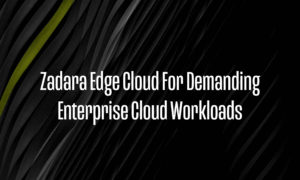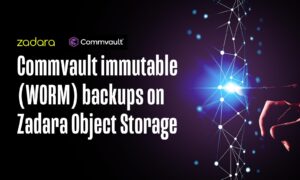Steve Healey, CTO of Pratum, a cybersecurity company, took on the challenge of handling a demanding workload in an enterprise cloud environment. His work involves dealing with storing and retaining a rolling 365 days worth of data, which translates into a significant data storage requirement. It’s also a high-speed, high-volume process, with between 35,000 and 45,000 events per second coming into the solution for long-term storage. That data must then be readily accessible so that users can run searches on it at any given point in time.
He explained that “we have real-time security metrics that are run against that volume of data, so we need the data to not only be persistent and stored long-term, but also on fast storage arrays that can be readily accessed in a minimal amount of time.” To realize these goals, Pratum is leveraging Zadara cloud storage to house its data. That way, as Steve put it, the data is “available to us so that we can query it very quickly.” Zadara offers fully-managed cloud services, including compute, networking and storage.
The Importance of Compute
Pratum’s workload is about more than just storage. For it to function as needed, the cloud compute aspect of the platform must also perform well. Steve remarked, “They’re scaling up their compute so that you can actually spin up servers and instances closer to your storage, all within Zadara.” To him, this delivers a benefit because it increases performance and reduces latency. He added that “I’ve been impressed with all of those features, and that capability is fairly new here. Staying cutting-edge and providing additional services is something that’s been very helpful to us as well.”
Integrating with other Solutions
Additionally, Pratum found Zadara’s integration with other cloud solutions to be critical to realizing the objectives of the project. Pratum has a presence within Amazon EC2, which enables the firm to leverage compute instances. Steve noted that “being able to integrate with compute, both locally within Zadara, as well as with other cloud vendors such as Amazon, is very helpful, while also being able to maintain extremely low latency between those connections.” Pratum has leveraged 10-Gig direct connections to be able to hook up the storage element within Zadara with other cloud platforms like Amazon Web Services (AWS), Google, and Rackspace. Steve stated, “That is one of the primary technical driving factors.”
In particular, Steve felt that integration across multiple clouds was necessary to counteract threats like ransomware. Such attacks can render data unusable and cause major operational disruptions. He remarked that “having backups and storage locations that you can push data to, offsite, or integrate with, is definitely key.”
Scalability as a Key Success Factor
Working with Pratum’s volume and velocity of data means that their enterprise cloud solution has to be highly scalable. Pratum found Zadara’s ability to scale up as needed, on-demand, without having to invest in hardware, particularly useful. Steve shared that “if we were to get a large client, a Fortune 500 or Fortune 100, that had a significant number of assets or data they were looking to monitor, being able to scale on demand and increase the drives behind the scenes is something that we can do in a matter of minutes today. If we were to manage that ourselves, it would take time to spin up those drives or to make those purchases and then get them configured and onboarded. We can now do that with the click of a button.”
Pratum shifted their workloads from Serial ATA (SATA) hard drives to solid stat drives (SSDs) on Zadara. This has led to an increase in performance of at least 100 to 200 percent. Steve shared that, in going from a single GB to 10 GBs, “performance-wise we’re in a completely different arena.” At the same time, they doubled and tripled their event ingestion count. This was necessary, too, as they have increased year-over-year with constant growth.
Their performance demands have grown significantly. But, as Steve said, “We’re not only able to keep up with that but exceed that, year-over-year. We can scale resources, increase the network, decrease latency, and increase the speed and the amount of CPUs and the amount of memory on those virtual private storage arrays as well, as needed.”
A further advantage of working in the enterprise cloud has been the ability to set up disaster recovery (DR) across the country. Pratum can accomplish replication and remote mirroring working this way. They can add additional storage by themselves, and change the configuration of the VPSA to scale up or scale down – making any changes to meet budgetary needs. Steve noted that “it truly allows us to manage things from a performance standpoint as well. We can also rely upon Zadara, as a managed-services provider, to manage those requests on our behalf.”
This blog was adapted from a review on IT Central Station. You can read the complete review here. Thank you to Steve for reviewing Zadara.
To learn more about Zadara cloud services view our solution brief or contact us for a demo.






